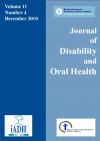Journal of Disability and Oral Health

- Cover Date:
- December 2010
- Print ISSN:
- 1470-8558
- Vol:
- 11
- Issue:
- 4
The impact of dementia on the care of dental implants: a case report
Introduction
The use of implants for the retention of a lower complete denture is becoming an increasingly common technique for patients who are faced with retention and stability difficulties when treated with conventional prostheses. The rehabilitation of the edentulous mandible with an implant-retained denture is now considered as gold standard (Saha and RayChaudhuri, 2009). Dementia is the broad term for a degenerative and progressive disease of neurological tissue. The most common form is Alzheimer Disease which accounts for 50-60% of diagnosed cases, although there are a number of other causes, examples of which include alcohol abuse and rarely Creutzfeld Jacob Disease (CJD). Vascular dementia is the second most common type and occurs as a result of a cerebrovascular accident (CVA) or small blood vessel disease within the brain. Dementia is marked by a reduced ability to cope with the activities of daily living due to a reduction in cognitive ability (Fiske et al., 2006; Alzheimer’s Society, 2009). There are a number of published national guidelines for the care of dementia patients both generally and in relation to their oral care (Jones et al., 2000; Fiske et al., 2006; National Institute for Health and Clinical Excellence, 2006). The difficulties faced by people with dementia in relation to their oral care are well documented. Cognitive deterioration can result in the loss of routine and a reduction in understanding of daily self care. This is often exacerbated by a physical inability to perform their own oral care. It has been shown that patients with moderate and advanced dementia have a poorer oral health status (Chalmers and Pearson, 2005). This case highlights the difficulties encountered in the maintenance of implants when a change in medical status reduced a patient’s ability to care for an osseointegrated implant-retained lower prosthesis. This is, to our knowledge, the first time this has been documented.
- Article Price
- £15.00
- Institution Article Price
- £
- Page Start
- 192
- Page End
- 194
- Authors
- Lorna A Laidlaw
Articles from this issue
- Title
- Pg. Start
- Pg. End
- Oral health status and dental treatment needs in institutionalised versus non-institutionalised psychiatric patients
- 163
- 170
- Oral health and children with an intellectual disability: a focus group study of parent issues and perceptions.
- 171
- 177
- ‘Emily goes to the dentist’ - oral care for individuals with Down syndrome in the Netherlands
- 180
- 182
- Oral radiological findings in a population of athletes at the III Para-Pan American Games, Rio de Janeiro, Brazil
- 187
- 191
